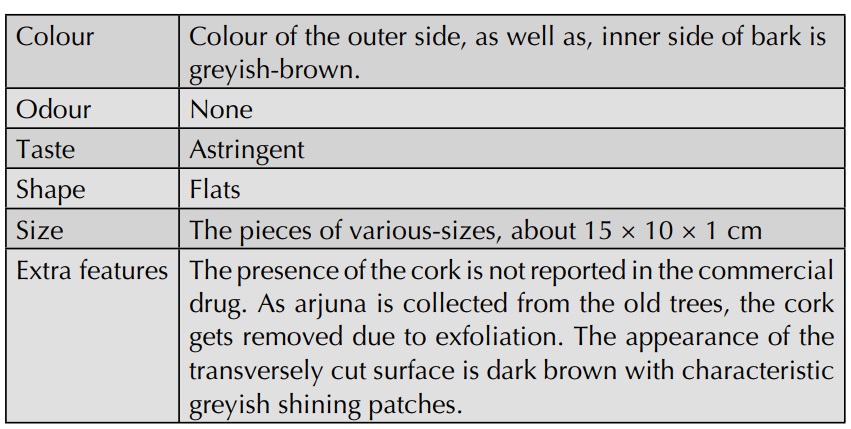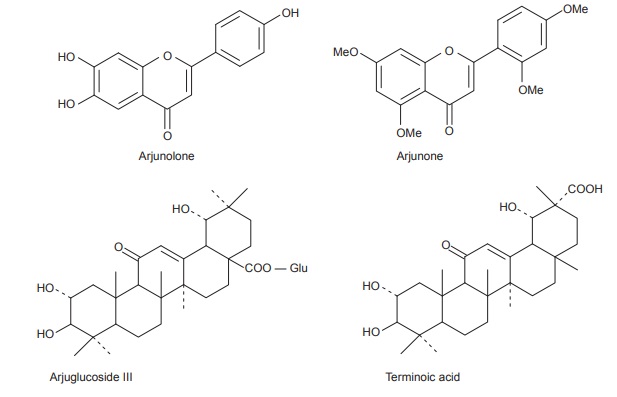Arjuna
| Home | | Pharmacognosy |Chapter: Pharmacognosy and Phytochemistry : Drugs Containing Tannins
Arjuna consists of dried stem bark of the plant known as Terminalia arjuna Rob, belonging to family Combretaceae.
ARJUNA
Synonyms
Arjun bark, arjun.
Biological Source
Arjuna consists of dried stem bark of the plant known as Terminalia arjuna Rob, belonging to
family Combretaceae.
Geographical Source
The tree is common in Indian peninsula. It is grown by the
side of streams and very common in Chotta Nagpur region.
Cultivation and Collection
Arjuna is found as naturally growing plant in the dense
forests. It is very common in Baitul in Madhya Pradesh and also in Dehradun.
Arjuna can be successfully raised by sowing seeds or by means of stumps. The
seeds take about 21 days for germination. It needs moist fertile alluvial loam
and rainfall in the range of 75 to 190 cm. It grows satisfactorily up to 45°C.
The bark is also collected from wild growing plants, and it is reported that
yield per tree varies from 9 to 55 kg.
Morphology

Microscopy
Transverse section of fresh bark shows cork composed of
uniformly arranged several layers of small, tangentially elongated cells.
Below cork is a region of cortex, composed of thin-walled, more or less
brick-shaped parenchymatous cells containing cluster crystals of calcium
oxalate. A few groups of sclerenchymatous pericyclic fibres are scattered in
the cortex. Secondary phloem consists of phloem parenchyma composed of
thin-walled, polygonal cells with wavy walls containing cluster crystals of
calcium oxalate and pigmented cells. Phloem fibres, composed of
sclerenchymatous cells, occur in groups and are scattered in the form of
patches in parenchyma. Narrow and almost straight medullary rays are also
present.
Chemical Constituents
The dry bark from the stem contains about 20 to 24% of
tannin, whereas that of the bark obtained from the lower branches is up to 15
to 18%. The tannins present in arjuna bark are of mixed type consisting of both
hydrolysable and condensed tannins. The tannins are reported to be present are
(+) catechol, (+) gallocatechol, epicatechol, epigallocatechol, and ellgic
acid. The flavonoids such as arjunolone, arjunone, and baicalein have been
reported from the stem bark. The triterpenoid compounds arjune-tin, arjungenin,
arjunglucoside I and II, and terminoic acid have also been reported from the
bark. The root contains number of triterpenoids such as arjunoside I and II,
terminic acid, oleanolic acid, arjunic acid, arjunolic acid, etc. The fruits
also contain 7 to 20% of tannins. A pentacyclic triterpenic glycoside
arjunoglucoside III has been reported from the fruits along with
hentriacontane, myristyl oleate and arachidic stearate.

Chemical Test
Ethereal extract of arjuna shows pinkish fluorence under
ultra-violet light.
Uses
Arjuna bark is used as a diuretic and astringent. The
diuretic properties can be attributed to the triterpenoids present in fruits.
It causes decrease in blood pressure and heart rate. It is used in the
treatment of various heart diseases in indigenous systems of medicines. The bark
was extensively used in the past by the local tanneries for tanning animal
hides. It yields a very firm leather of a colour which is similar babool tanned
leather.
Adulterants
The dried bark of the plant Terminalia tomentosa is used as an adulterant for the drug.
However, it can be distinguished from arjuna bark by fluorescence test.
Ethereal extract of arjuna gives pink fluorescence, whereas T. tomentosa gives pale blue.
Marketed Products
It is one of the ingredients of the preparations known as
Abana, Geriforte, Liv 52, Mentat (Himalaya Drug Company), Arjun Ghrita, Arjun
churna (Baidyanath Company), and Madhudoshantak (Jamuna Pharma).
